QUESTIONS
SECTION A (40 marks)
Answer all the questions in this section in the spaces provided.
-
- List two courses offered in vocational institutions that a student studying woodwork can pursue after completing secondary school education.(1 mark)
- Explain the following principles of design:(2 marks)
- Unity ......
- Variety .....
-
- State two uses of a vernier caliper.(2 marks)
- State two disadvantages of large scale businesses.(2 marks)
-
- Give three advantages of oil stones over water stones.(3 marks)
- Explain the term "grading" as applied in timber.(2 marks)
-
- State the use of a coping saw. (1 mark)
- State two advantages of using a coping saw. (2 marks)
- Sketch and label a sliding bevel.(4 marks)
-
- List four tools used in veneering. (2 marks)
- State two disadvantages of natural seasoning.(2 marks)
-
- List four types of natural glue used in woodwork.(2 marks)
- Figure 1 shows an exploded view of a butt hinge.
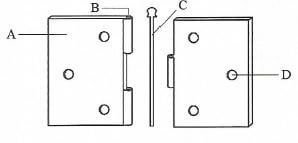
Figure 1
Name the parts labelled A, B, C and D.(2 marks)
- State four reasons for applying finish on a wood product.(4 marks)
- Use sketches to show the difference between a feather joint and a dowelled joint.(4 marks)
- Figure 2 shows a template drawn to a scale of 1:2.
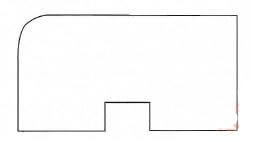
Figure 2
Dimension the template fully. (5 marks)
SECTION B (60 marks)
Answer question 11 on the A3 paper and any other three questions from this section in the spaces provided. Candidates are advised not to spend more than 25 minutes on question 11.
- Figure 3 shows three views of a block drawn in first angle projection
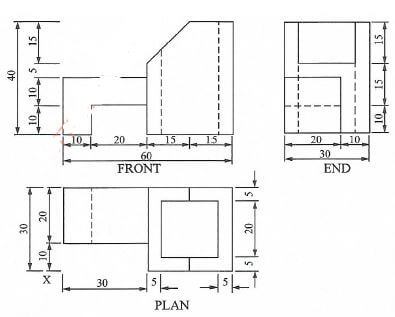
Figure 3
To a scale of 2:1, draw the block in isometric projection taking X as the lowest point.(15 marks) -
- List two types of spokeshave and state one use of each.(3 marks)
- List four types of saw jigs giving one use of each. (6 marks)
- Distinguish between a rip saw and cross cut saw. (6 marks)
-
- State two advantages of bleaching wood. (2 marks)
- Outline the procedure of administering first aid treatment to a minor burn on the palm.(5 marks)
- List and explain four processes carried out during maintenance of hand saws. (8 marks)
-
- Outline the procedure of preparing a timber surface ready to receive varnish. (7 marks)
- With the aid of sketches, explain the difference between mortise chisel and paring chisel, stating one use of each.(8 marks)
-
- Describe the following types of manufactured boards.(6 marks)
- Lamin board.
- Chipboard.
- Figure 4 shows an exploded view of a housing joint
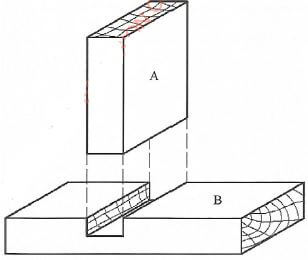
Figure 4
Outline the procedure of marking and making the joint using hand tools.(9 marks)
- Describe the following types of manufactured boards.(6 marks)
MARKING SCHEME
-
- Courses offered in vocational institutions
- Carpentry and joinery
- Building construction
- Upholstery
- Cabinet making
- Painting and sign writing
- Interior design
- Principles of design
- Unity/ Harmony
It is an arrangement among elements in a design such that they look as though they belong together. - Variety
It is a variation on a visual theme causing contrast in design for example using of different thickness.
- Unity/ Harmony
- Courses offered in vocational institutions
-
- Functions of a Vernier caliper
- Measuring external dimensions.
- Measuring internal dimensions.
- Measuring depths of objects.
- Disadvantages of large scale business
- Complexity of managing the business.
- High cost of human capital.
- Decision making may take a long time.
- Competition is high
- Higher taxation.
- Functions of a Vernier caliper
-
-
- Advantages of Oilstones over Waterstones
- Oilstones require less maintenance as they wear less rapidly.
- Oilstones have lower long term costs.
- Oilstones have an excellent edge.
- Oilstones do not produce filing dust.
- Oilstones have less friction as compared to water stones.
- They are not prone to rusting
- Advantages of Oilstones over Waterstones
- Grading .
- It is the categorization of timber into ranges of quality.
- It considers the defects in timber, strength method of conversion among other factors.
-
-
- Functions of a coping saw
- To cut curves in wood and plastic with thickness not exceeding 15mm.
- Advantages of a coping saw
- The blade can be rotated easily to cut the required shapes and curves.
- The blade can be removed from the frame and turned or twisted.
- The blades are cheap to replace.
- Functions of a coping saw
-
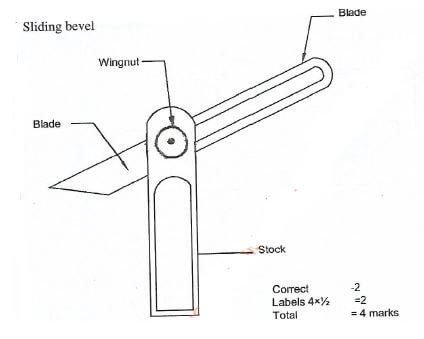
-
- Tools used in veneering
- Veneer hammer
- Veneer saw
- Veneer pins
- Veneer tape
- Knives
- Shooting board
- Cutting mat
- Rules/straight edges
- Disadvantages of natural seasoning
- Difficult to control the rate of drying.
- Uneconomical as it takes a long time.
- Difficult to obtain a uniform moisture content.
- Tools used in veneering
-
- Types of natural glue used in woodwork
- Animal glue
- Blood glue
- Casein glue
- Soya beans glue
- Parts of a butt hinge
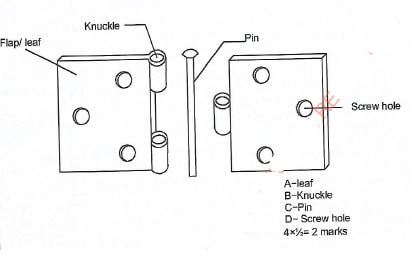
A-leaf
B-knuckle
C-pin
D-screw hole
- Types of natural glue used in woodwork
- Reasons for applying finish on a wood product
- For aesthetic purposes i.e. beauty.
- To protect the wood surface from weathering.
- To conceal certain defect.
- To provide a cleanable surface.
- To increase the durability of the product.
- Methods of strengthening a glued widening joint
- Use of dowels (Doweled Joint)
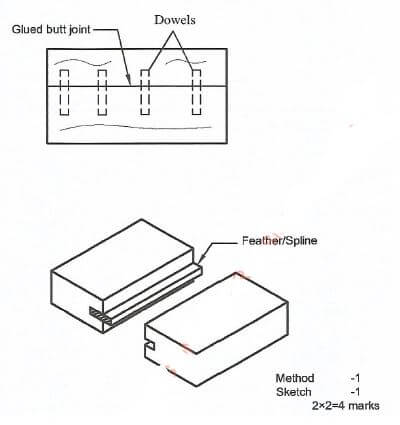
- Use of splines or feathers
- Use of dowels (Doweled Joint)
-
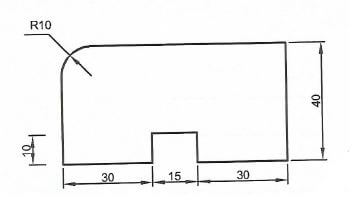
scale = 1 mark
correct drawing = 1 mark
any 4 correct dimension (4 x 1/2) = 2 marks
dimension lines = 1/2 mark
arrow heads = 1/2 mark
5 marks total -
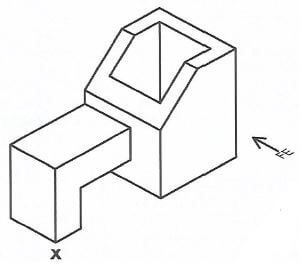
Scale 2:1 = 1 mark
Isometric projection = 1 mark
Correct position at X = 1 mark
F.E correctly presented = 4 marks
E.E correctly presented = 4 marks
Plan correctly presented = 4 marks
15 marks total -
-
- Types of spoke shave
- Flat sole spoke shave
- Uses:- Planing on a convex surface.
- Planing narrow pieces is a straight line. - Round sole spoke shave
- Uses- Planing concave serves on timber.
Types - 2x1/2 = 1
Uses - 2x1 = 2
3 marks
- Types of spoke shave
- Types of saw jigs and use of each
- Length gauge - used for quick and accurate repetition cutting to length in cross cut mode.
- End grain jig - used when working on end grain.
- Hold down jig - used to hold down narrow pieces when rigging.
- Bevel cutting jig - used when cutting a bevel with a saw.
- Taper ripping jig - used when repeatedly ripping narrow work pieces that taper.
- Bevel ripping jig - used when cutting bevels on materials wider than 450mm.
- Outboard work support - used to support large panels when ripping in the table saw mode or when cross cutting long material.
Any 4 types (4 x 1) = 4 marks
4 uses of the 4 above (4 x 1/2) - 2 marks
6 marks
- Difference between a rip saw and cross cut saw
Accept sketches as solutions if providedRip saw Cross cut saw - Have 4 to 41/2 teeth per 25 mm
- Used for cutting along the grain.
- Cut on the forward stroke only.
- Have a length between 650 and 660mm
- Teeth are filed to give a chisel edge.- Have 7 to 9 teeth per 25 mm
- Cut across the grain.
- Cut a little on the return stroke.
- Smaller in length - 600 to 710mm.
- Teeth filed to form a knife edge.
-
-
- Advantages of bleaching wood.
- It lightens dark wood to required hues.
- It does not interfere with tear the wood fibers.
- It does not require special equipment.
- It enables change of the original color of wood entirely or partially.
- Procedure of administering First Aid treatment to a minor burn on the palm.
- Soak the bumed portion in cold water.
- Wash burned area in soapy water.
- Dry gently
- Apply a sterile gauze over the burned area.
- Bandage the burned area snugly.
- Processes carried out during maintenance of hand saws
- Topping
It involves bringing all the teeth points in line. A long saw file is drawn over teeth. - Shaping
This is restoring the teeth to their original shape and size. The file face is held level and square to the saw blade throughout the process. - Setting
This is a bending the tips of the teeth to give the saw blade clearance when cutting. - Sharpening
This is filing the cutting edges of all teeth with a file.
Processing = 4
Explanation = 4x 1
8 marks
- Topping
- Advantages of bleaching wood.
-
- Procedure of preparing a timber surface for varnish.
- Complete the final sanding, remove dust, dirt or grease.
- Sponge the surface with warm water and let it dry for twelve hours.
- When dry, sand all surfaces with sand paper.
- Apply a coat of varnish Allow eight hours to dry and sand it lightly with medium sand paper.
- If working on open grained wood, apply a paste filler and allow it to dry for twenty four hours.
- Sand the filler coat with fine sand paper when dry.
- Seal the filler with a coat of white shellac and when dry sand again with fine sand paper.
- The timber surface is ready for varnishing.
Any 7 points
- Difference between mortise and paring chisel
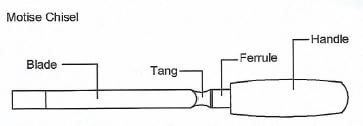
- Has deeper blades.
- Has parallel edges.
- Used to cut out mortises.
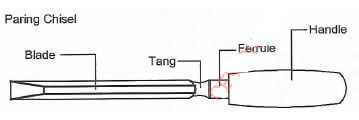
- Has beveled edges.
- Has longer blades.
- Used in situations where others are unable to reach e.g housing joints
Correct sketches = 2 x 2 = 4 marks
Differences - Any 2 x 2 x1 = 4 marks
8 marks
- Procedure of preparing a timber surface for varnish.
-
- Types of manufactured boards
- Lamin board
- It is a board having a core made up of strips of wood, glued to form a block which is further glued between two or more outer veneers.
- The direction of the grains of the core blocks is at the right angles to that of adjacent outer veneers.
- The strips in lamin board are less than 12mm thick.
- Chip board
- Consists of wood chips bonded together and pressed to make a uniform board.
- It may be obtained but sometimes it is faced with a veneer.
- It is difficult and unsatisfactory to cut joints in chipboard and it does not hold screws well.
Accept sketches if given as the solution.
- Lamin board
- Procedure of making a housing joint
- Square two pieces of A and B using a try square.
- Locate one side of the groove and square a line across the face of member B
- Place member A along the marked line and mark the width of the housing with a pencil or marking knife.
- Mark the depth of the joint with a marking gauge.
- Cut the sides of the joint ensuring that the saw cut is on the waste side.
- With a sharp chisel, remove the waste material in the groove until the joint reaches the required depth.
- A router plane can also be used to remove the waste.
- Using a depth gauge, test that the bottom of the joint is of the required depth.
- Test to determine whether the parts fit accurately, if necessary trim the groove with a chisel - Assemble the two pieces A and B to form the joint.
- Types of manufactured boards
Join our whatsapp group for latest updates
Tap Here to Download for 50/-
Get on WhatsApp for 50/-
Download KCSE 2018 Woodwork Paper 1 with Marking Scheme.
Tap Here to Download for 50/-
Get on WhatsApp for 50/-
Why download?
- ✔ To read offline at any time.
- ✔ To Print at your convenience
- ✔ Share Easily with Friends / Students

